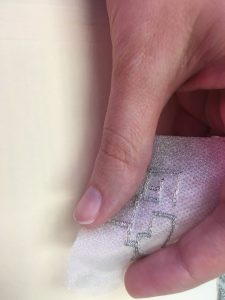[ad_1]
Of course, various forms of technology have already been added to clothing – such as LED dresses – but elements such as antennas and batteries, would need to be detached before washing the garment.
Asimina Kiourti, Assistant Professor of Electrical and Computer Engineering at The Ohio State University, has been working to change things.
 Specifically, her team at the ElectroScience Laboratory is embroidering electronics directly into fabrics using conductive threads, which they call “e-threads”.
Specifically, her team at the ElectroScience Laboratory is embroidering electronics directly into fabrics using conductive threads, which they call “e-threads”.
She says, on theConversation.com:
“The e-threads we’re working with are bundles of twisted polymer filaments to provide strength, each with a metal-based coating to conduct electricity. The polymer core of each filament is typically made out of Kevlar or Zylon, while the surrounding coating is silver. Tens or even hundreds of these filaments are then twisted together to form a single e-thread that’s usually less than half a millimeter across.”
“These e-threads can be easily used with common commercial embroidery equipment – the same computer-connected stitching machines that people use every day to put their names on sports jackets and sweatshirts. The embroidered antennas are lightweight and just as good as their rigid copper counterparts, and can be as intricate as state-of-the-art printed circuit boards.”
The good news is that the e-thread antenna can also be combined with traditional threads, enabling logos or specific designs carry integrated antennas.
“We’ve been able to embroider antennas on fabrics as thin as organza and as thick as Kevlar. Once embroidered, the wires can be connected to sensors and batteries by traditional soldering or flexible interconnections that plug components together.”
Antenna smart hats
Examples of what the researchers have already been able to create using their antenna system include “smart hats“, to read deep brain signals for patients with Parkinson’s or epilepsy, and T-shirts with antennas, extending the range of Wi-Fi signals to the wearer’s mobile phone.
Another idea is foldable antennas that measure how much a surface – covered by the fabric – has bent or lifted.
Read the full article, which also describes work at The Ohio State to make flexible, fabric-based miniature power generators.
Thanks to Sue P. for highlighting this one.
Images: ElectroScience Lab
[Via Smithsonian.com]
[ad_2]
Source link

